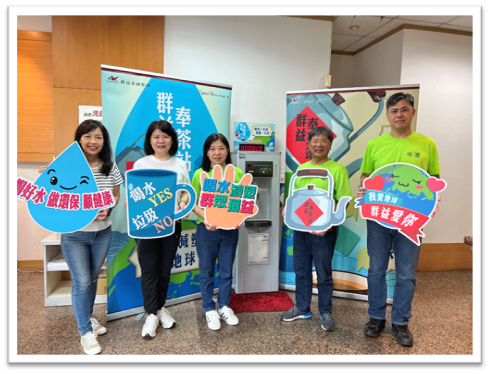IR Calendar
Home 》About
Capital 》CSR Program and Achievement --- ---1203
Energy saving / carbon reduction measures and results
Capital Securities, in response to the National Net Zero Emission Policy and to utilize the influence of the securities industry, actively promotes the greenhouse gas inventory and verification from itself, from which it develops strategies and action plans for energy conservation and carbon reduction, and supervises the progress of implementation in order to identify and deal with the related impact activities.
Energy management
The Company has adopted a management system and a series of energy conservation measures to improve the
energy mechanism, in order to effectively manage energy consumption and enhance efficiency, while
helping to
reduce operating costs, and also achieve environmental care and sustainable development commitments. It
is
expected that by the end of 2030, the average annual reduction will be 1.43% compared with the base
year.
| Base Year | Short-term Target (2024) |
Mid-term Target (2025) |
Long-term Target (2030) |
|---|---|---|---|
| 2023 | 1.43% reduction from base year | 2.86% reduction from base year | 10% reduction from base year |
First, we have adopted a systematic approach to manage and supervise energy use and efficiency within
the
organization, and then regularly identify opportunities for improvement and evaluate the effectiveness
of
energy-saving measures and controls to ensure that resources are invested in a way that achieves the
expected benefits. In addition, we regularly review the utilization of contracted capacity annually to
ensure the implementation and effectiveness of low-carbon strategies and action plans.
| Energy Saving Measures | Environmental protection recognition | Quantity | Energy Saving Benefits(kWh/year) | Resources Invested(NT$) |
|---|---|---|---|---|
| Replacement of LED lighting fixtures | Energy Saving Label | 106 sets | 14,195 | 92,644 |
| Replacement of air-conditioning equipment | Energy Saving Label | 2 sets | 1,752 | 57,000 |
| Replacement of multifunction printers | Dust Free | 2 sets | 48,338 | 107,280 |
| Total | 64,285 | 256,924 | ||
The Company's energy usage is mainly comprised of outsourced electricity used in the course of business
services at each of its operating locations, and a small amount of gasoline and diesel fuel consumed by
its
company vehicles and emergency generators.
- 1. Boundary: All business locations in Taiwan.
- 2. Base year: 2023.
- 3. The types and amounts of energy used are, in descending order, outsourced electricity, diesel fuel, and gasoline, and the respective energy consumption is analyzed in the table below.
| Capital Securities’ Energy Use Analysis Over the Years | ||||
|---|---|---|---|---|
| Year | 2022 | 2023 | Unit | |
| Energy typ | Outsourced electricity | 9,890,058 | 9,815,408 | kWh |
| Diesel fuel | 4,982 | 2,222 | Liter | |
| Gasoline | 12,527 | 12,428 | Liter | |
| Energy consumption | 36,171.59 | 35,801.88 | Gigajoule (GJ) | |
| Energy intensity | 6.41 | 6.41 | Gigajoules (GJ) / per NT$ 1 million in revenue |
|
| Percentage of increase/decrease in energy intensity over the previous year | Increase 143.72% |
Decrease of 47.33% |
- | |
Note 1:
Energy intensity is calculated using operating revenue (millions of revenue/NT$) as the denominator
(rounded to the second decimal place).
Note 2: Energy consumption was converted according to the "Energy Products Unit Calorific Value Table" in the 2020 Energy Statistics Handbook of the Energy Administration, Ministry of Economic Affairs (MOEA), electricity: 860 kcal/kWh, diesel: 8,400 kcal/liter, gasoline: 7,800 kcal/liter.
Note 2: Energy consumption was converted according to the "Energy Products Unit Calorific Value Table" in the 2020 Energy Statistics Handbook of the Energy Administration, Ministry of Economic Affairs (MOEA), electricity: 860 kcal/kWh, diesel: 8,400 kcal/liter, gasoline: 7,800 kcal/liter.
Greenhouse Gas Emissions
Greenhouse Gas Emission Policy
Capital Securities is aware of the impact of climate change and environmental ecology by greenhouse gases,
in
order to fulfill the corporate responsibility for environmental protection, we are committed to the
greenhouse
gas inventory, to truly control the status of greenhouse gas emissions, and to adjust the greenhouse gas
emission reduction action plans and plans in a rolling manner through the P-D-C-A cycle of improvement
management methodology, and to put forward the following commitments to environmental sustainability:
- 1. Continuously promote the implementation measures to reduce greenhouse gas emissions.
- 2. Actively evaluate and utilize renewable energy.
- 3. Comply with national environmental protection laws and regulations.
- 4. Follow the national net-zero carbon emission target.
Greenhouse Gas Management Organization and Structure
The Company has established a greenhouse gas inventory executive team, which is responsible for issues such
as
improving energy efficiency, energy conservation measures, evaluating the use of renewable energy,
greenhouse
inventory and emission control, and emission reduction measures. In addition, the Company conducts bi-weekly
reports and discussions on issue impacts in the Environmental Sustainability Section under the Sustainable
Management Office, and then reports quarterly to the Sustainable Development Committee on issue trends,
action
plans, and target achievement status.
In the end, the Sustainable Development Committee makes a resolution and reports or discusses the content to the Board of Directors, so that it can effectively supervise the progress and resource investment. It is expected that by the end of 2030, the Scope 1 and Scope 2 emissions will be reduced by an average of 1.43% per annum compared with the base year.
In the end, the Sustainable Development Committee makes a resolution and reports or discusses the content to the Board of Directors, so that it can effectively supervise the progress and resource investment. It is expected that by the end of 2030, the Scope 1 and Scope 2 emissions will be reduced by an average of 1.43% per annum compared with the base year.
| Base Year | Short-term Target (2024) |
Mid-term Target (2025) |
Long-term Target (2030) |
|---|---|---|---|
| 2023 | 1.43% reduction from base year | 2.86% reduction from base year | 10% reduction from base year |
Energy Usage and Greenhouse Gas Emissions Inventory
The Company continues to promote the ISO14064-1 greenhouse gas inventory, and has commissioned a third-party
verification organization in 2023 to assess the completeness and correctness of the inventory information in
advance, and has been assured of its completion by KPMG Taiwan in April 2024, reaching a new milestone in
greenhouse gas information management and greenhouse gas emission reduction.
| Capital Securities' Greenhouse Gas Emissions Analysis Unit: tCO2e | ||||
|---|---|---|---|---|
| Year | 2022 | 2023 | ||
| Direct Greenhouse Gas Emissions (Scope 1) | 447.24 | 357.23 | ||
| Indirect Greenhouse Gas Emissions (Scope 2) | 5,034.04 | 4,858.63 | ||
| Total | 5,481.28 | 5,215.86 | ||
| Greenhouse Gas Emission Intensity (tCO2e/million in revenue) |
0.971 | 0.492 | ||
| Emission intensity increase/decrease percentage over the previous year |
- | Decrease of 49.35% | ||
Note 1:
The source of data is the electricity bill, electricity allocation table of the building, and gasoline
voucher.
Note 2: Scope 1 emission factor is based on “Greenhouse Gas Emission Factor Management Table (Version 6.0.4) of Ministry of Environment, Executive Yuan”.
Note 3: The power factor is based on the power emission factor announced by the Energy Administration of the Ministry of Economic Affairs (0.495kgCO2e/kWh in year 2022).
Note 4: Emission intensity is calculated using operating revenue (million in revenue/ NT$) as the denominator (rounded to the third decimal place).
Note 2: Scope 1 emission factor is based on “Greenhouse Gas Emission Factor Management Table (Version 6.0.4) of Ministry of Environment, Executive Yuan”.
Note 3: The power factor is based on the power emission factor announced by the Energy Administration of the Ministry of Economic Affairs (0.495kgCO2e/kWh in year 2022).
Note 4: Emission intensity is calculated using operating revenue (million in revenue/ NT$) as the denominator (rounded to the third decimal place).
Low Carbon Strategies and Action Plans
The accumulation of awareness and consensus among employees is the key to achieving energy conservation.
Therefore, we regularly organize training, response, and awareness-raising activities for employees to
educate
them on how to adopt energy-saving measures in their daily work. At the same time, through bonuses and
competitions, employees are implicitly involved in energy management, which is accepted by employees and
leads
to the formation of a corporate culture.
| Greenhouse Gas Reduction Action Plans | |
|---|---|
| Strategy | Action Plan |
| Personnel respond to low carbon action |
|
| Energy saving activities at business locations |
|
| Replacement for high energy consumption or old equipment |
|
| Improve official vehicle use efficiency |
|
| Green Procurement | Through our procurement system, we promote the procurement of green products by requiring suppliers to provide products that meet the standards of environmental protection, energy conservation, and green building materials, or green products that comply with the requirements of recycled materials and low pollution that have the same performance and less impact on the environment. In addition, we pay attention to the improvement of resource utilization efficiency of various office and electrical equipment, and actively supervise and implement them. |
| Continuous improvement mechanism | Regularly review the contracted capacity usage every year to ensure the proper implementation and effectiveness of low carbon strategies and action plans. |
Resource and Waste Management
In the face of the severe challenge of increasing global water scarcity, the Company is committed to
promoting
the sustainable management of water resources to ensure that while water resources create economic value for
the
Company, they can also be properly and reasonably utilized and protected.
Establishment of water resources management
The Company has established a water resources management target and conducts regular monitoring of all
departments and business locations within the organization to assess the potential for water saving, which
is
expected to be reduced by an average of 1% per annum compared to the base year by the end of 2030.
| Base Year | Short-term Target (2024) |
Mid-term Target (2025) |
Long-term Target (2030) |
|---|---|---|---|
| 2023 | 1% reduction from base year | 2% reduction from base year | 7% reduction from base year |
The Company's water consumption has no significant impact on water resources.
- 100% of the Company's water sources are tap water, and there is no use of groundwater or other sources of water supply. The sources of water in Taiwan, the main operating area, are from the Taiwan Water Corporation and the Taipei Water Department.
- The Company's wastewater is domestic wastewater, which is mainly used for drinking water, air-conditioning systems, cleaning, etc. It is used by employees and customers, and the wastewater is legally discharged to the sewage system after use, or discharged into the effluent system according to the requirements of the local community to comply with the standards for discharging domestic wastewater.
Active Publicity and Education
In addition to organizing regular publicity and education activities to explain the correct concepts of
water use, we also post water conservation slogans near water-using equipment to cultivate the habit of
water conservation. In particular, the severe water shortages in the spring and summer seasons of the past
few years have increased employees' awareness of the issue of water scarcity, and have encouraged the
implementation of water-saving measures in the workplace and at home.
Continuous Improvement
We continue to seek management systems, new equipment and technology to improve water conservation and
efficiency. For example, we install water-saving devices to regulate water output, replace old
water-consuming equipment, use water-conserving equipment with water-saving labels, and even evaluate the
introduction of intelligent equipment and energy-saving monitoring facilities to facilitate the more precise
management of water resources usage.
The above measures can effectively enhance the efficiency of water resources usage and contribute to the protection of water resources, demonstrating the Company's strong commitment to the sustainable development of the environment.
The above measures can effectively enhance the efficiency of water resources usage and contribute to the protection of water resources, demonstrating the Company's strong commitment to the sustainable development of the environment.
| Tap Water Consumption Analysis | |||
|---|---|---|---|
| Year | 2021 | 2022 | 2023 |
| Water consumption (kWh) | 25,160 | 52 ,374 | 52,422 |
| Increase/decrease over the previous year | Decrease of 14% | Increase of 108% | Increase of 0.092% |
| Number of employees in the whole organization | 1,977 | 1,876 | 1,910 |
| Average water consumption per person (kWh/person) | 12.73 | 27.93 | 27.45 |
Note 1:
The significant increase in 2022 data is due to the new inclusion of allocation of public water
consumption at the Dunnan Office (Stock Agency Department) and the head office in the water consumption
inventory.
Note 2: The source of data is the water bill and the water consumption allocation table of the building.
Note 3: The number of employees in the whole organization increased by 1.81% in 2023 compared to that in 2022, which led to an increase in total water consumption, but the success of water conservation resulted in a decrease in the average water consumption per person.
Note 2: The source of data is the water bill and the water consumption allocation table of the building.
Note 3: The number of employees in the whole organization increased by 1.81% in 2023 compared to that in 2022, which led to an increase in total water consumption, but the success of water conservation resulted in a decrease in the average water consumption per person.
Waste Management
Capital Securities has been actively implementing waste management and setting targets in an attempt to
promote a high level of recycling economy by turning waste into resources to minimize environmental
impacts
to address resource scarcity and environmental pollution issues. In addition, Capital Securities is also
contributing to the achievement of greenhouse gas emission reduction targets, which are expected to be
reduced by an average of 1% per year by the end of 2030 as compared to the base year.
| Base Year | Short-term Target (2024) |
Mid-term Target (2025) |
Long-term Target (2030) |
|---|---|---|---|
| 2023 | 1% reduction from base year | 2% reduction from base year | 7% reduction from base year |
Classification and Reduction of Wastes
The Company operates in the financial services industry, and its waste is mainly domestic waste. The
Company
strictly implements the strategy of waste reduction at source and waste recycling classification, and
requires its employees to distinguish between general waste and resource recycling, with the former
being
transported to the incineration plant by the local property management company of the building or a
qualified waste disposal company for treatment, and the latter being handled by the professional and
qualified recycling company for proper disposal of the recyclables.
In promoting the greenhouse gas inventory project, to ensure the completeness and correctness of waste statistics, the Company conducts regular measurements of all its waste, and the types and data are listed below.
In promoting the greenhouse gas inventory project, to ensure the completeness and correctness of waste statistics, the Company conducts regular measurements of all its waste, and the types and data are listed below.
| Capital Securities’ Waste Analysis | ||||
|---|---|---|---|---|
| Unit: metric tons | ||||
| Type | Item | Treatment method | 2022 | 2023 |
| Non-recyclable | General waste | Incineration | 67.4838 | 60.5561 |
| Recyclable | Confidential documents | Water soluble treatment | 39.57 | 39.57 |
| Total weight of waste | 107.0538 | 101.4061 | ||
| Recycling Rate | 37% | 40% | ||
| Usage increase/decrease from the previous year | - | Decrease of 5.6477 | ||
| Percentage of increase/decrease over the previous year | - | Decrease of 5.3% | ||
| Number of operating locations in Taiwan | 1,876 | 1,910 | ||
| Average water consumption per person (kWh/person) | 57.0649 | 53.0921 | ||
In view of the waste statistics, the Company has implemented recycling activities for waste through
publicizing and encouraging measures to help reduce waste generation, which in turn results in the
reduction
of greenhouse gas emissions.
Continuous Improvement and Collaboration
The Company continuously tracks and evaluates the effectiveness of waste management. At the same time,
the
Company actively cooperates with other enterprises to jointly promote the recycling of resources and
circular economy issues.
Green Procurement
Starting from the Company's procurement system, the Company promotes the requirement at the procurement
stage that suppliers provide products that meet the standards of green products such as environmentally
friendly, energy-saving, and green building materials labels, or environmentally friendly products with
the
same performance and less impact on the environment, such as recycled materials and low-pollution
products.
Meanwhile, we also pay attention to the improvement of resource use efficiency of various office and
electrical equipment, and actively supervise and implement them at the end of the process.
| Procurement Category | Green Procurement Label | Amount of Green Procurement(NT$) | Percentage of Green Procurement |
|---|---|---|---|
| Repair and maintenance |
|
1,114,000 | 3.6% |
| Equipment |
|
25,515,000 | 27.2% |
| Office Supplies | Overseas PEFC label | 1,418,000 | 28.9% |
| Others |
|
6,657,000 | 9.9% |
| Total | 34,704,000 | 17.7% | |
Other Green Transformation Campaigns
In addition to the environmental protection measures mentioned above, Capital Securities has been
actively
promoting other green transformation campaigns, which are briefly described below:
Three major digitization measures to help promote green transformation
- The first measure is to digitize account opening.
We promote the opening of securities accounts, the opening of e-accounts, the opening of trust accounts,
the
opening of 3-in-1 accounts (credit, securities lending, and borrowing) through our webpage and APPs, and
other online account opening channels, which helps reduce the overall greenhouse gas emissions from
customers' transportation and waiting at the counter.
- The second measure is to digitize transactions.
We offer service-based/transaction-based APPs, such as the promotion of “Capital Securities Mobile
Winner
Smart Transaction” and “LINE@ Social Community Platform”, which not only reduce the use of paper and
care
for the environment, but also contribute to the benefits of greenhouse gas reduction. To date, our APPs
have
been downloaded nearly one million times, with a growth rate of 90% in the last two years.
- The third measure is to digitize reconciliation of accounts.
We provide customers with electronic statements for all financial products and continue to promote
them
through various activities, striving to effectively reduce energy and resources such as printing
paper, ink,
and multifunction printer energy consumption, as well as to promote greenhouse gas emissions
reduction and
reduce the impact of environmental pollution.
- At the same time, in order to facilitate the use of digital technology by all customer groups, reduce their waiting time, and realize the goals of financial inclusion and fair treatment of customers, we have designed easy-to-understand explanatory videos and instructional videos to explain and demonstrate online account opening and electronic transactions. In addition, we provide warm instructional explanations at each of our operating locations in order to implement digital equality.
Green Digital Transformation within the Organization
- Announcing various information via online bulletin boards and reducing photocopying of paper information
- Actively promoting the adoption of electronic signature mechanism.
- Without violating the management system, we promote the improvement of resource use efficiency, such as: recycling and reuse of non-confidential or non-customer information documents, encouraging electronic files to replace paper, replacing fax paper with e-mail, and other digital green measures.
Responding to Environmental Activities
Professional Cooperation on “ESG Tree Planting and Carbon Sink
In response to the call of the social enterprises “Green Hope Spring” and the “Online UBrand of United Daily News”, Capital Securities, together with Taitung residents, gave a different gift to Taiwan through the “Tree Planting Activity”. We sponsored the planting of 10 Diospyros philippensis trees, a native species of Taiwan, at the Green Tree Avenue demonstration site in Zhenxing Village, Chishang Township, where the conversion of the land from betel nut trees has allowed us to conserve soil and water and capitalize on the value of the land in the future. We hope that people from all walks of life can pay attention to sustainability issues and plant a better future for Taiwan.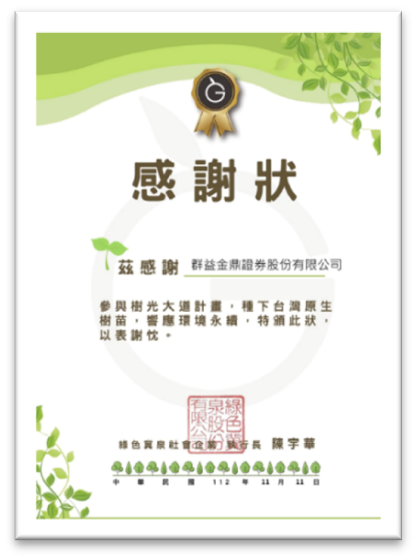
Key Results
A 10-year-old Diospyros philippensis tree can absorb 180 kgCO2, reduce 472 kgCO2e, and produce 94,551 kg
of
oxygen per year, and it can also retain 352 metric tons of groundwater and reduce approximately 1,895 kg
of
soil erosion. We have planted hope and made commitments to protect the land and reduce greenhouse gas
emissions for decades and even centuries, echoing the spirit of the United Nations Sustainable
Development
Goals (SDGs) No. 17, and realizing the goals of green finance and sustainable finance.
Turn Off the Lights for 1 Hour on Earth Day and Plant Trees to Love the Earth
In response to the “Turn off the Lights for 1 Hour” campaign, the Company has turned off the lights for
1
hour at its head office and 52 branch offices across Taiwan. Moreover, on its corporate website, the
Company
called on its customers and employees to jointly respond to the event by saving electricity and caring
for
the Earth, demonstrating that the Company's promotion of sustainability is no longer just a slogan, but
is
also a serious implementation of the goals of sustainable development and sustainable finance. Not only
do
we contribute to the capital market, but we also contribute to the sustainability of the earth, and we
hope
that the future society will benefit from the benefits of the Capita Financial Group.
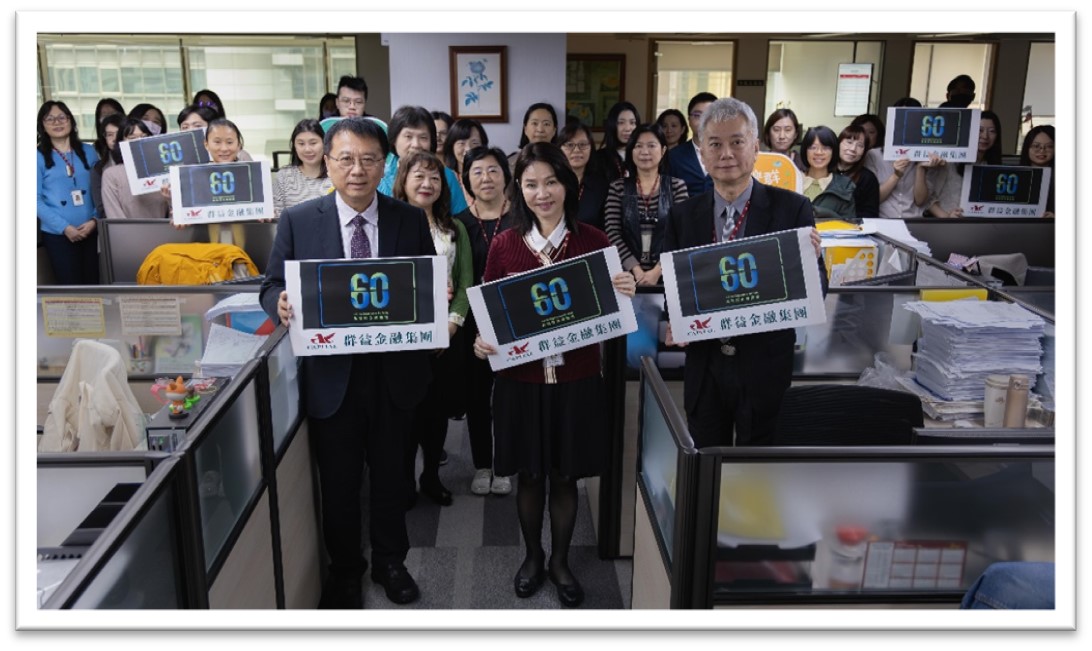
Moving forward to the Lujiao Creek Wetland to protect the earth and maintain the water environment
In 2023, the Company responded to the CommonWealth Magazine's call to “do something for the Tamsui
River”
and actively fulfilled the Tamsui River Convention. We took our employees to the Lujiao Creek Wetland to
support environmental protection and love for the earth through a series of activities such as water
quality
monitoring, aquatic organism observation, bird survey, identification of local native species, and
removal
of the Mikania micrantha, a strong invasive species. Through on-site exploration and experience, we have
the
opportunity to educate our employees and their families on the importance of biodiversity and
maintaining
the ecological balance of the wetlands.
Through this activity, we hope to arouse the public's awareness of water resources and environmental conservation, protect local native species, safeguard biodiversity, and internalize environmental care as part of our daily lives.
Through this activity, we hope to arouse the public's awareness of water resources and environmental conservation, protect local native species, safeguard biodiversity, and internalize environmental care as part of our daily lives.
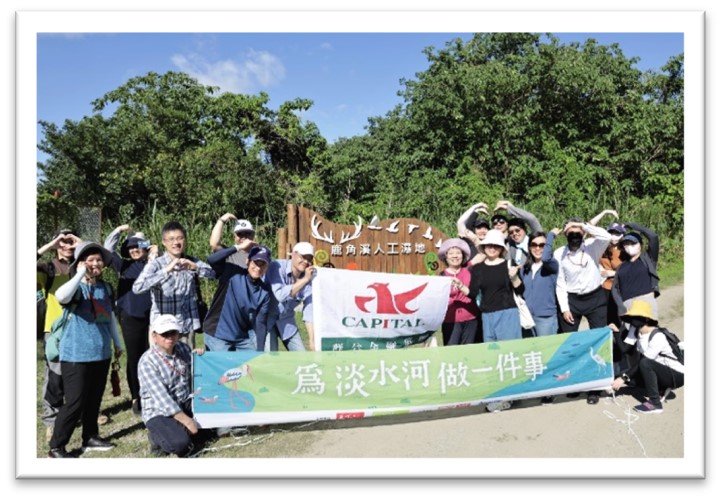
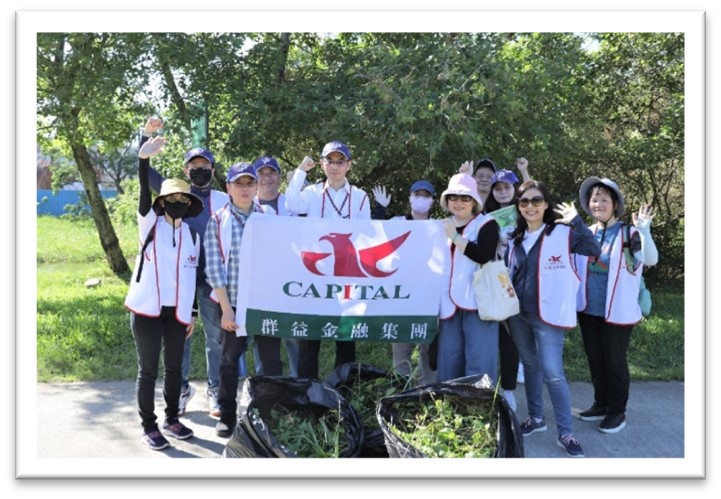
Capital Securities Tea Offering Station:Together for Plastic Reduction and Love the Earth
Capital Securities and ACUO, the leading manufacturer of water dispensers, have jointly organized the
“Tea
Offering” campaign. Since September 2023, Capital Securities has launched the “Capital Securities Tea
Offering Station” in each of its business locations, and installed “Love the Earth Plastic Reduction
Counter” in the water dispensers to allow customers and employees to bring their own containers of water
and
at the same time, they can recognize the amount of bottles they have reduced for the Earth, and feel
proud
of their efforts in caring for the environment and reducing plastics to love the Earth.
By the end of 2023, a total of 106,986 plastic bottles have been reduced, resulting in a reduction of carbon emissions by 13 tCO2.
(※A 600ml plastic bottle produces about 0.121 kgCO2e of greenhouse gas emissions.)
By the end of 2023, a total of 106,986 plastic bottles have been reduced, resulting in a reduction of carbon emissions by 13 tCO2.
(※A 600ml plastic bottle produces about 0.121 kgCO2e of greenhouse gas emissions.)
